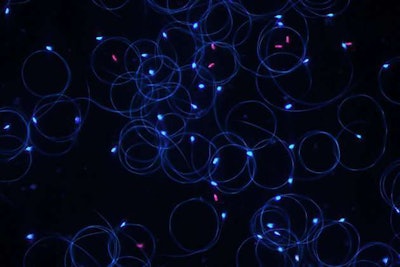 Male honeybees’ sperm, seen here under a microscope, declined nearly 40 percent after exposure to neonics. Photo: Lars Straub, University of Bern
Male honeybees’ sperm, seen here under a microscope, declined nearly 40 percent after exposure to neonics. Photo: Lars Straub, University of BernA study has revealed that two types of the controversial neonicotinoids – insecticide ingredients often referred to as “neonics” – have significant negative effects on male honeybees.
Researchers from the University of Bern in Switzerland found that thiamethoxam and clothianidin reduced the number of living sperm in male honeybees by 39 percent compared with bees that had not been exposed to the insecticides.
Along with this discovery, the scientists also concluded that the chemicals decrease the lifespan of the drones. Those exposed to the neonicotinoids live an average of 15-22 days, a lifespan 32 percent shorter than unexposed drones.
“Most neonicotinoid studies that employ honeybees have focused on workers, which are typically the non-productive females of the colony,” said Lars Straub, a doctoral student at the university and the lead author of the study. “Male honeybees have really been neglected by honeybee health scientists; while not surprising, these results may turn a few heads.”
The findings were published in the biological research journal Proceedings of the Royal Society B, which is based in London but is worldwide in membership and publication; for example, its editorial board includes both American and Canadian biologists.
The two neonicotinoids responsible for this unintentional birth control were banned by the European Union in 2013, but they are still commonly used in the United States for agricultural purposes.
Bee decline has been a steady concern for the past decade. Despite raised awareness and intermittent, if modest, improvement from time to time, beekeepers have experienced continued losses.
According to a national survey, beekeepers lost 44 percent of their honeybee colonies from April 2015 to April 2016. This is the second year in a row that colony losses have exceeded 40 percent.
Although many focus blame for the bee losses solely on neonicotinoids, Straub points out that they are just one factor.
“There are heaps of different factors that can actually affect colony health,” Straub told The New York Times. “Pesticides alone are probably just one of the small pieces of the bigger puzzle.”
The U.S. Environmental Protection Agency is currently investigating thiamethoxam and clothianidin, along with dinotefuran, and is scheduled to release its risk assessment in December.









